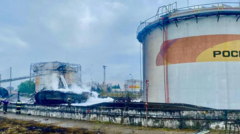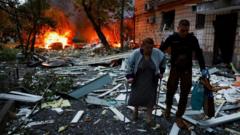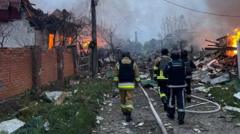While cities like Kyiv face relentless drone attacks and nightly air raid alerts, the remote Transcarpathia region remains largely untouched. Residents enjoy a semblance of normalcy, highlighting the discrepancies in wartime experiences across Ukraine.
### In the Eye of the Storm: Life in Transcarpathia Amid Ukraine’s War

### In the Eye of the Storm: Life in Transcarpathia Amid Ukraine’s War
The Transcarpathia region of Ukraine offers a stark contrast to the ongoing violence seen in other parts of the country, providing an unusual refuge in the midst of conflict.
The article text:
Mukachevo, a picturesque city in Ukraine’s westernmost Transcarpathia region, is experiencing an unusual sense of normalcy amidst the chaotic backdrop of the ongoing war. As young people congregate at a local supermarket, the laughter and lively discussions shimmer against a haunting silence that characterizes much of the rest of the country, particularly in cities like Kyiv that have recently endured extensive drone assaults.
In the heart of this region, the reality remains starkly different. “Here, we do not hear the sound of explosions, we do not have rockets, we do not have frequent air alarms,” says local resident Oleksandr Pop, 20, underscoring the relative calm that envelops Transcarpathia. For the last three years, this mountainous region has seen minimal conflict, contrasting sharply with the escalating violence faced by other parts of Ukraine.
From Mukachevo to Uzhhorod, the heart of Transcarpathia seems to defy the chaotic scenes elsewhere in the nation. This area has been spared from the extensive night-time curfews imposed in most of the country, allowing life to carry on with an air of normalcy. Indeed, local cafes and bars serve as gathering spots, embodying the resilience of a community largely untouched by the conflict that has transformed urban centers into arenas of war.
While Kyiv has faced record-long hours of air alerts—the capital recently experiencing alarms for nearly 130 hours in one month alone—Transcarpathia has only encountered a fraction of that anxiety. With few drones or missiles reported hitting the region, the residents live in a state that feels almost like what life might have once been before the onset of war.
This seeming oasis amid turmoil raises questions about the uneven impact of conflict within Ukraine. While the war rages on elsewhere, Transcarpathia stands as a reminder of both the resilience and disparity experienced by those in different regions of the country—a poignant metaphor for the broader implications of war on community, resilience, and normality. As residents continue to debate over midnight snacks by the riverside, their experiences starkly contrast with the ongoing struggles of many in the war-torn nation, a testament to the complexities of life in a country grappling with conflict.
Mukachevo, a picturesque city in Ukraine’s westernmost Transcarpathia region, is experiencing an unusual sense of normalcy amidst the chaotic backdrop of the ongoing war. As young people congregate at a local supermarket, the laughter and lively discussions shimmer against a haunting silence that characterizes much of the rest of the country, particularly in cities like Kyiv that have recently endured extensive drone assaults.
In the heart of this region, the reality remains starkly different. “Here, we do not hear the sound of explosions, we do not have rockets, we do not have frequent air alarms,” says local resident Oleksandr Pop, 20, underscoring the relative calm that envelops Transcarpathia. For the last three years, this mountainous region has seen minimal conflict, contrasting sharply with the escalating violence faced by other parts of Ukraine.
From Mukachevo to Uzhhorod, the heart of Transcarpathia seems to defy the chaotic scenes elsewhere in the nation. This area has been spared from the extensive night-time curfews imposed in most of the country, allowing life to carry on with an air of normalcy. Indeed, local cafes and bars serve as gathering spots, embodying the resilience of a community largely untouched by the conflict that has transformed urban centers into arenas of war.
While Kyiv has faced record-long hours of air alerts—the capital recently experiencing alarms for nearly 130 hours in one month alone—Transcarpathia has only encountered a fraction of that anxiety. With few drones or missiles reported hitting the region, the residents live in a state that feels almost like what life might have once been before the onset of war.
This seeming oasis amid turmoil raises questions about the uneven impact of conflict within Ukraine. While the war rages on elsewhere, Transcarpathia stands as a reminder of both the resilience and disparity experienced by those in different regions of the country—a poignant metaphor for the broader implications of war on community, resilience, and normality. As residents continue to debate over midnight snacks by the riverside, their experiences starkly contrast with the ongoing struggles of many in the war-torn nation, a testament to the complexities of life in a country grappling with conflict.























